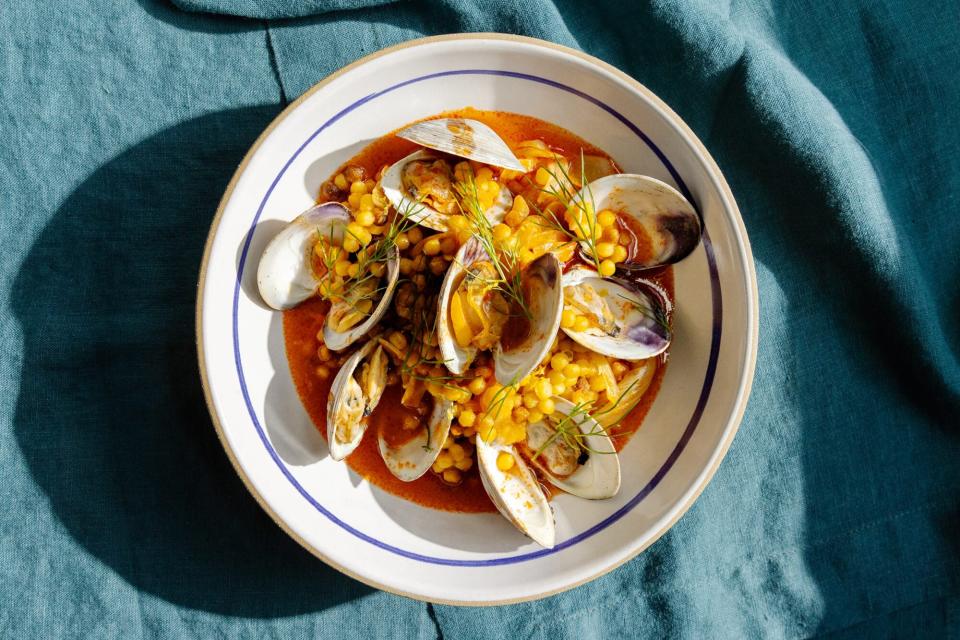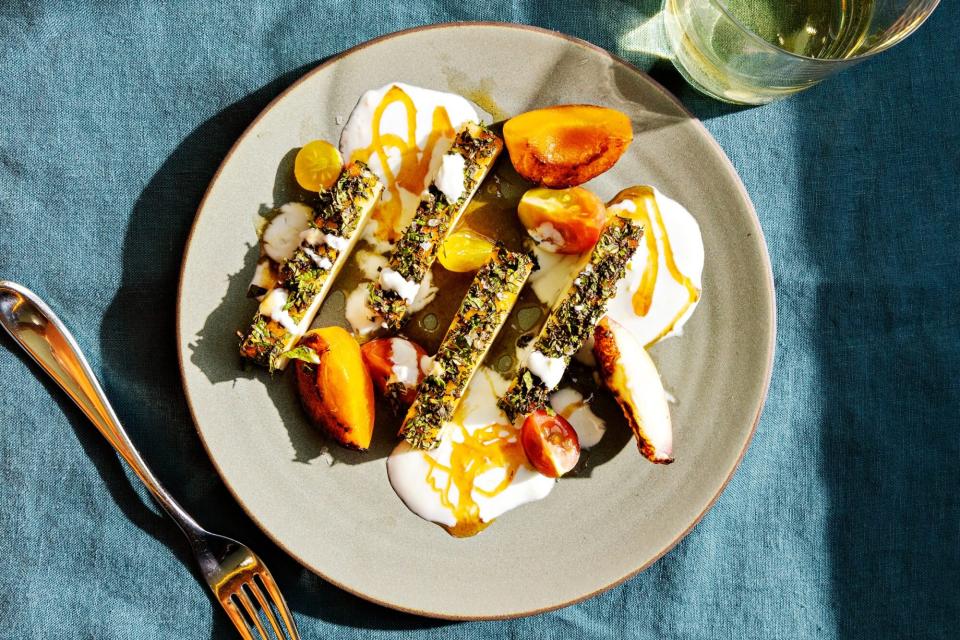How a Menu Is Made
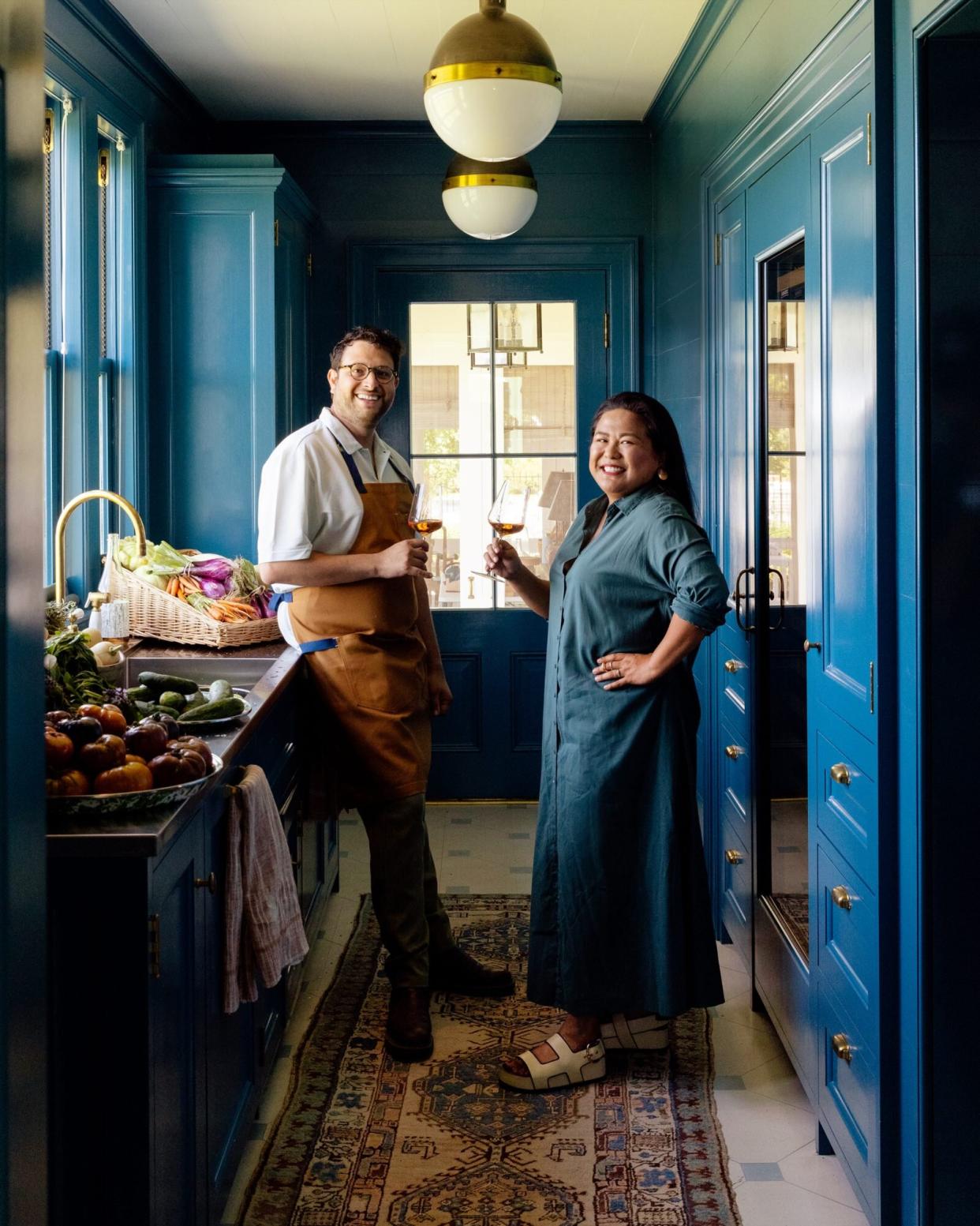
Cedric Angeles
Felipe Riccio is kicking a ball around at Goodthyme Farm, calling words of encouragement to his soccer buddy: a miniature donkey named Darla. She butts the ball with her snoot. "It's her favorite sport!" he yells. When I'd arrived at the farm earlier that morning, I didn't expect to find myself watching a chef playing with a small donkey, but then, much of what I would learn during my time with Riccio and his team — their philosophy and how their Houston restaurant, March, operates — would prove just as unexpected.
Goodthyme Farm, a little over an hour from Houston, is a country retreat owned by entrepreneurs Bailey and Pete McCarthy, Riccio's business partners. Together with Master Sommelier (and 2014 Food & Wine Sommelier of the Year) June Rodil, the four of them are Goodnight Hospitality, which currently runs three venues in one building: fine-dining restaurant March, live-fire pizza and pasta palace Rosie Cannonball, and casual retail café Montrose Cheese & Wine. Goodthyme supplies produce to the group's restaurants as well as to the city's Urban Harvest Farmers Market, but more importantly (as far as I was concerned), the McCarthys often throw open their doors to the restaurant team for research and menu development.
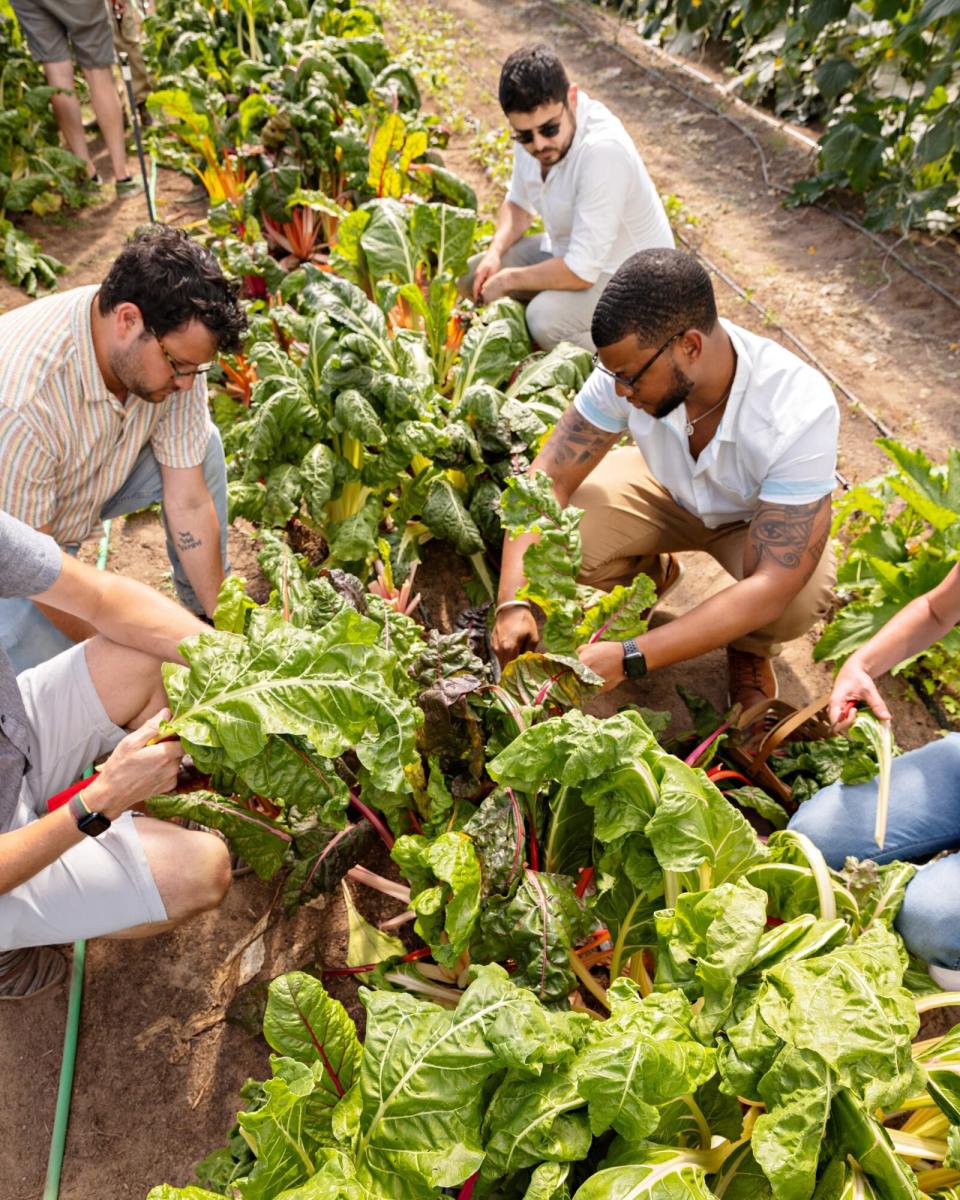
Cedric Angeles
"The team cooked the entire Rosie Cannonball menu here before opening weekend," Riccio tells me, a little breathless from his soccer game. I'm here because they're going to spend the next couple of days at the farm developing and then fine-tuning the recipes that will be the foundation of March's next tasting menu, launching in September.
March, which opened in 2021, goes deep into the regional cuisines of the Mediterranean, "from the Strait of Gibraltar to Beirut," as Riccio puts it. The menu changes focus twice a year. From this past February to August, Riccio focused on interpretations of dishes from the historic region of Occitania (which includes the Languedoc region in Southern France, parts of Spain, Italy, and Monaco); the menu launching in September will focus on islands — Corsica, Sardinia, Malta, and Menorca.
Riccio chose to focus on the Mediterranean because it's the cuisine he likes to cook most. His passion is influenced by his Naples-born father and Spanish mother, who worked in hotels in their adopted Mexico. ("I grew up in Mexico eating Italian food at home," he says.) Nearly two years based in Europe as an adult fueled that interest. While his wife, Hayley, (who is part of a design team at NASA) completed her master's degree in Milan, Riccio staged at storied restaurants across the continent: Osteria Francescana in Modena, Italy; Aga in the Dolomites; and Azurmendi, outside Bilbao, Spain. Much like those high-end restaurants, Riccio wanted "clearly defined boundaries" for March.
Among its other meanings, the word march can mean a frontier or border area. While the restaurant team prepares lunch, we gather around the massive kitchen island in the farmhouse, and Riccio explains the overall idea for March. It's inspired, he says, by the "edge effect" in the riparian zone. "What the hell is that?" I ask, while his business partner Rodil laughs heartily in the background. She explains that it's where two ecosystems meet, usually the land and the sea, and often features a great deal of biodiversity. "The idea is that the restaurant is exploring the series of marches where the greatest tension and diversity exists in food," Riccio says. As is clear, Riccio is a cerebral guy. But if what he's describing sounds a tad earnest, the outcome is definitely not — his cooking is exacting, but also delicious and playful.

Cedric Angeles
Rodil, who has won accolades for her hospitality superpowers as the restaurateur behind the award-winning June's All Day in Austin, is a good foil for Riccio. The sense of joy that she radiates is powerfully disarming and is exactly what makes her and her front-of-house team so good at translating the kitchen's philosophy to guests at March. Later that afternoon, sitting in the kitchen, patting the McCarthys' small pink poodle, Minnie, she explains why she and Riccio have such good synergy. Riccio took a break from cooking after culinary school to learn about wine and ended up becoming a certified sommelier, she says. This is how the duo met; for a while, Rodil didn't even know that Riccio was a chef: "When I found out, I remember thinking, 'Oh, my God, Felipe can cook?!'"
As a result, wine pairings are an integral part of the March experience. "One of my favorite things is talking through food and my pairings with chefs," explains Rodil. "Pairings are what made me want to get into the wine industry. I remember being a server captain early in my career, and the restaurant where I worked did pairings. I'll just never forget the revelation I had: If you put two things together that really work, the result is stronger than the individual parts! It's magical." Rodil and her team, led by beverage director Mark Sayre, head up a world-class wine list and cellar. On any given night, roughly half the restaurant's guests will opt for one of the wine pairings with the six- or nine-course tasting menus. Rodil finds it infinitely exciting. Whenever possible, she tries to match the origin of the food with a wine from the same region. But she never forces anything: Taste, texture, and balance must ultimately win the day.
Riccio takes the same approach. "We are not replicating; we're interpreting," he says as he tastes the Fregula cun Cocciula, a dish of clams and a Sardinian couscous-like rolled pasta being prepared for lunch. "The inspiration for a dish could be a flavor of the region, or an ingredient, or something that's growing well at the farm. But how do we tie it all together?"

Cedric Angeles
Often, the thread that connects it all is history. "I'm interested in the origin of the style of cooking I enjoy," he explains. Riccio and his team often create the restaurant's menus with their noses in history books (see "A Cook's Library," below), which explains how he's able to rattle off how Stuffat Tal-Fenek, rabbit braised in a rich wine-and-tomato sauce, became the national dish of Malta. (Rabbit-hunting on the island was once purely the pastime of the ruling knights and gentry, but when the British took over in the early 19th century and loosened hunting restrictions, the peasants celebrated by embracing it — so much so that a rabbit stew became the dish of the land.)
Collaboration is another through line at March. Each chef on the senior team takes on a research project and is given the opportunity to contribute a dish to March's menu. That collaborative spirit also extends to their work with Goodthyme's head farmer, Jack Jones, who used to be a chef himself. Jones takes special requests from March, growing herbs like a fragrant Corsican mint with the tiniest leaves, nepitella (a wild Italian herb that tastes a bit like the love child of mint and basil), za'atar, and nasturtiums. Jones grows whatever works well in the Texas heat and sandy soil, including up to 20 types of tomatoes. He nominates the Blue Cream Berries as his favorite: "It's floral and acidic all at once; it tastes like sunshine," he says. For its part, March evolves its menu during its run to reflect the changing produce on the farm.

Cedric Angeles
The sense of camaraderie was everywhere during my time at Goodthyme, as the chefs prepped in the kitchen over easy conversation and laughter; as they nerded out on new varieties of tomatoes; and certainly as the entire team, partners and all, jumped in unison — fully clothed — into the pool at the end of lunch to celebrate the fact that their work for the day was done.
But how does all this collaboration, research, and farm cookery come to life at March? Rodil draws an analogy with a fashion show. "I think about the tasting-menu experience at the restaurant like the season on a runway," she says. "It has to flow and have its entrance, middle, end, and a grand finale."
Naturally, I had to experience March for myself, so I headed to Houston to try the Occitania tasting menu. When I arrived at the restaurant, I was ushered into the lounge, where I was offered an aperitif and lounge snacks like a dainty braised onion tart and a perfectly crumbed and deep-fried olive stuffed with mushroom duxelles to go with my March Martini. The experience was utterly relaxing and charming, and that's the point. "We start you in the lounge to disarm you; it's more welcoming and eases you into the night," says Rodil.
Once I headed into the dusty-pink dining room with its floor-to-ceiling tapestry at one end, the evening showcased incredible attention to detail. I sat at a linen-topped table with a bespoke screw-in top designed by Hayley Riccio (and perched my handbag on a little stool crafted by Rodil's husband, Aaron). Champagne was whisked from a vintage French enamel ice bucket to fill my glass, and precise and playful food — like an elegant riff on classic dishes such as cassoulet and cod brandade — was presented to me on stunning hand-fired ceramics.
After spending a day at the farm listening to the March team's approach, it was truly delightful to see it come to life. The fashion show analogy from earlier seemed apt: March is a place where food, design, hospitality, and ambiance combine in the most harmonious of ways. It excels at subtlety and nuance, at surprise and delight. Similar to the delight you feel when you watch a miniature donkey play soccer, really.
A Cook's Library
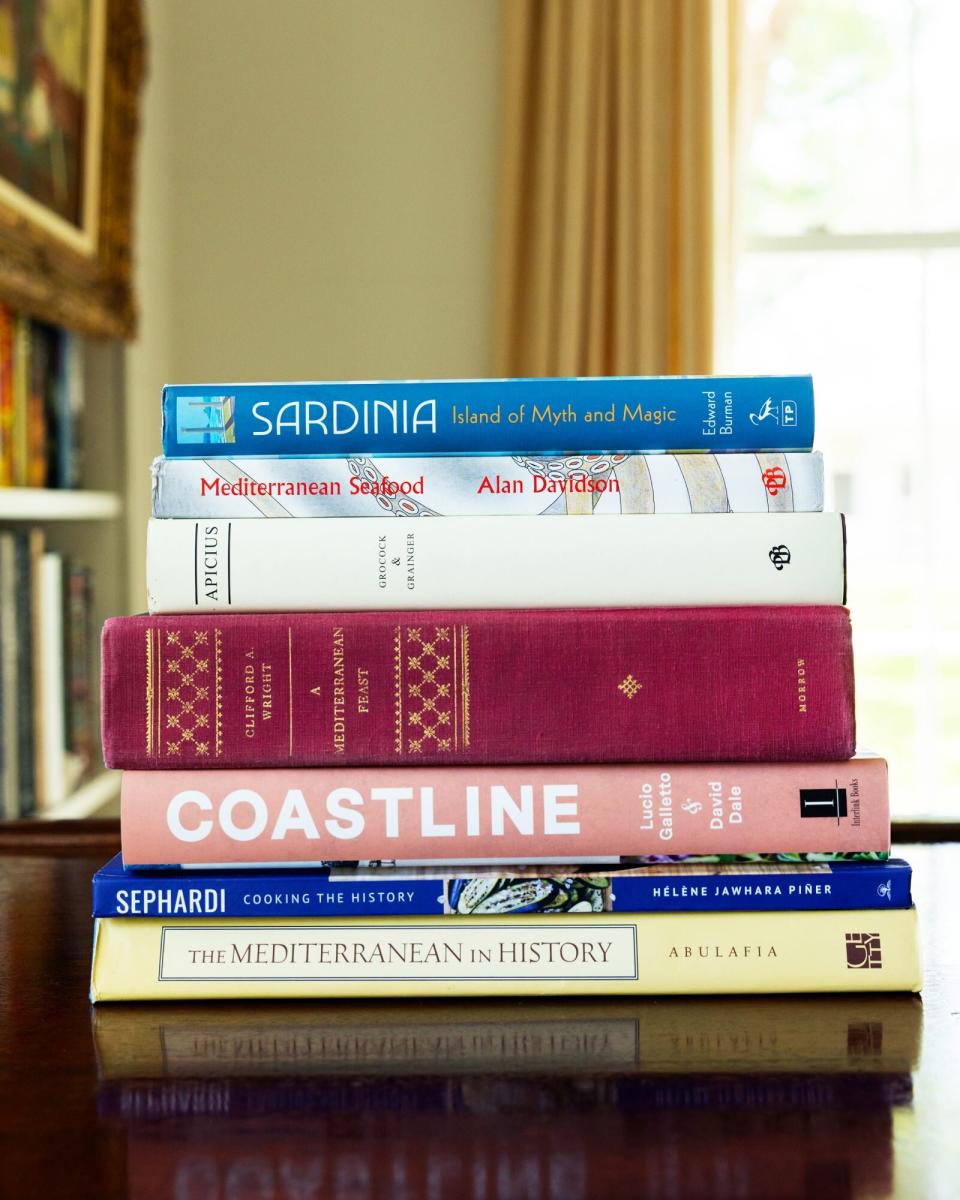
Cedric Angeles
Mediterranean Seafood by Alan Davidson "This is an amazing reference book that helps us understand seafood from a region with many varieties. Perfect for cooks who seek inspiration, knowledge, and confidence." — Felipe Riccio
Apicius translated by Christopher Grocock and edited by Sally Grainger "This book is a translation of an ancient collection of Roman recipes compiled around the fourth or fifth century. It's incredibly geeky but super interesting!" — FR
A Mediterranean Feast by Clifford A. Wright "One of the most important books informing this restaurant, a real anchor, and our No. 1 reference. There's so much culture, language, and history intertwined in this one book." — FR
Sephardi by Hélène Jawhara Piñer "This speaks to the migration of Sephardi Jews to the Mediterranean to North Africa, southern Spain, and Northern Italy and how that migration has affected food." — FR
Coastline by David Dale and Lucio Galletto "Threading a line between the major cuisines of the Mediterranean is not new, but this book does it so well. It highlights the uniqueness of each country but doesn't let you forget how intertwined they are. Great classic recipes, just a bit touched up." — FR
Sardinia by Edward Burman "A great example of a book that dives deep into one place in the Mediterranean. It goes into the entire history of one island and is a great reference to its culture and cuisine." — FR
The Mediterranean in History edited by David Abulafia "This is as history nerd as it gets, a tremendous compilation by eight historians about all the cultural influences the Mediterranean has seen." — FR
